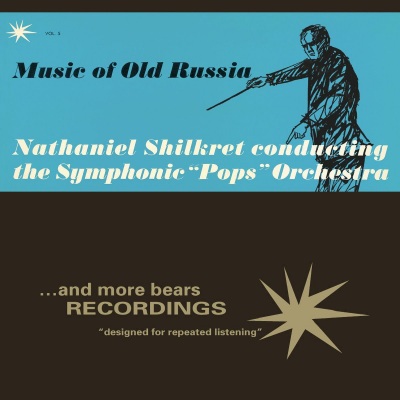当前位置:首页 >> Vol. 5 Music Of Old Russia >> 歌曲列表 第1页

Vol. 5 Music Of Old Russia
In this collection Nathaniel Shilkret and the Symphonic “Pops” Orchestra present through the use of original scores and new arrangements, a glimpse of Old Russia, reflecting the barbaric origins of the Russian people and the imperial splendor of the Tsar’s courts. Russia in olden times was roughly divided into two sections. The northern part, a wild mountainous country was first inhabited by passive nomadic tribes. The southern area, separated from the north by a huge forest, is the famous Russian Steppe where lived the famed Cossacks and other wild marauding tribes, people given to vigorous and robust living. This vigor and love of life and battle is pictured in Anton Rubinstein’s (1829-1894) lively Trepak. His Cavalry Trot, although not specifically designated as a representation of the Cossacks, the best horsemen of Europe, certainly was influenced by their presence in the imperial cities of Russia and by the numerous folk-tales of their valour. When Catherine the Great (1729-1796) sat on the imperial Russian throne, the emphasis of Russian thinking turned toward Western Europe. Everything of a Western and particularly of a French tinge was idolized at the Imperial Court. As a result, emissaries were sent to Paris to study Western customs in order to teach these attitudes to the Russians. The musicians who traveled on behalf of their country returned to compose in a French style, but their output was heavily tinted with Russian and oriental sounds. Early Russian music contained elements that sounded strange and barbaric to Western ears. For example Nightingale by Alabieff (1787-1851), orchestrated by Franz Liszt, is ostensibly nocturnal yet by the use of unusual harmonies and melodic line its quiet and serenity is underlined with a feeling of the primeval. The early attempts at imitating the French gradually disappeared and Russia’s great national composers of the nineteenth century established the characteristic style and tone colors by which Russian music is known today. Modest Moussorgsky (1839-1881), a composer of powerful originality, used realism as a means to mold the folk melodies of Russia into accepted musical patterns. Coming as he did from peasant stock, he had an awareness of nature that is clearly discernible in his descriptive Chick’s Ballet from the piano piece ‘Pictures From An Exhibition.’ This charming work evoked the sounds of a chicken yard with hens clucking and chicks scrambling for food in their own clumsy manner. During the nineteenth century, musical romanticism again brought new currents into Russian music. Nikolai Rimsky-Korsakoff (1844-1908), the master of orchestration and rich tonal colors, often chose oriental subject matters for his operas and tone poems. One of his best known melodies The Hymn To The Sun from the opera ‘Le Coq D’or’ is heard in this collection in Shilkret’s own modernized arrangement, which superimposes a modern touch on the original melody. One of Rimsky-Korsakoff’s pupils, Anton Arensky (1861-1906), was able to compose in both the traditional Russian and Western styles. Romance definitely shows the Russian influence, whereas Coquette is a good example of the Cosmopolitan style. The swift and grotesque The Faun, a descriptive piece of music by Vasilii Andrieff (1862-1918), adds further contrast to the program. And Sergei Prokofieff (1891-1953), a great figure in modern musical history, is represented in this collection with Kije’s Wedding from his ‘Lieutenant Kije Suite,’ a satirical composition based on the reign of the Tsars.
专辑歌曲列表
共有10首











